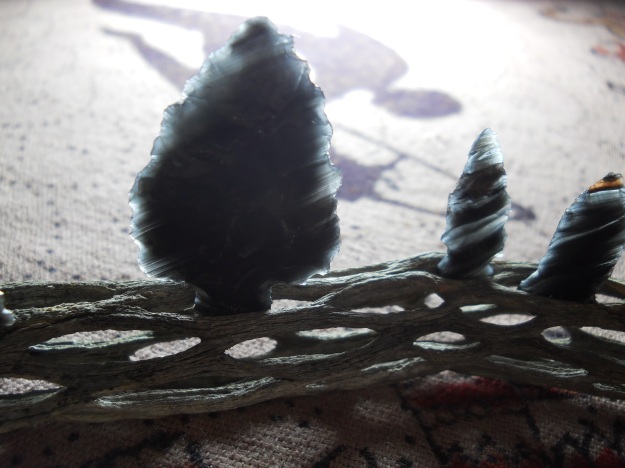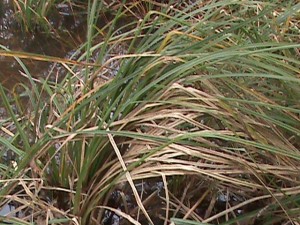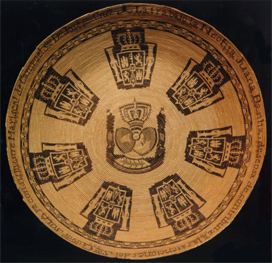Recently, news articles have been suggesting that the earliest archeological finding of human inhabitants in all the Americas is at at Toca da Bastiana rockshelter at Serra da Capivara National Park, Piaui, Brazil. At this sandstone overhang shelter, rock paintings of red ochre symbolizing humans, animals, and designs were found.
These “cave-paintings” were found under a 2 mm thick layer of the mineral calcite, suggesting the antiquity of the paintings. Calcite is formed when water deposits calcium-rich minerals on a rock surface over time, which builds up gradually with successive wettings and dryings of the rock surface. Very similar to how stalactites and stalagmites form in caves. When the calcite crystals first form out of aqueous solution, their radioactive decay first begins, and so they keep the radio-carbon “signature” of the time of their formation.
Watanabe et al. (2003) decided to radio-carbon date the calcite layer, since they supposed all the calcium had formed anew from being dissolved in water. They found the calcite to be 35,000 to 43,000 years old, and inferred the rock paintings were at least this old.
This would predate the second oldest known site by over 20,000 years!
Besides this Brazil study, the oldest known Americans lived some 13,000-15,000 years ago, 40 miles northwest of Austin in Central Texas at the Buttermilk Creek complex (Waters et al. 2011). This site is an extensive dig with tons of artifact with lots of support for the dating. A site in Washington and others nearby correspond to this same time frame (Waters et al. 2011b). These sites predate the Clovis culture by a few thousand years. There is an extensive literature and archeological record from the Clovis culture (13-12 kya) forward.
However, Rowe and Steelman (2003) at Texas A&M performed “direct” radio-carbon dating on the paint itself used at the Serra da Capivara rock painting site and found the various images to date from different times 1200- 3600 years ago. They also dated the calcite layer dated by Watanabe et al. (2003), and found it to date only 2490 +/- 30 years before present.
Rowe and Steelman (2003) suggest Watanabe et al. (2003) did not account for the incorporation of calcite dust from the surrounding riverbed / bedrocks into the nascent aqueous calcite that formed the calcite layer in front of the paintings. The incorporation of this calcite dust, which would date millions of years old by itself since it was precipitated out of aqueous solution at the same time as the surrounding bedrock, severely skewed the dating of the layer of calcite over the paintings (Rowe and Steelman 2003). Watanabe et al. (2003) apparently assumed all the calcite they were dating was all formed at the same time from aqueous mineralization, ignoring the possibility of dust being settling on the wet rock face and becoming part of the calcite layer. Rowe and Steelman (2003) conclude “once again, and most dramatically, these studies point to the necessity of independent studies dating rock art.”
Unfortunately many if not all of the news stories out there make no mention of this rebuttal study, which was published just 6 months after the original one. Even both the official websites of Serra da Capivara National Park and UNESCO World Heritage present the 36,000 + year old date as uncontested fact, making no mention of any disputes in the dating. The same websites complain of a dearth of visitors who should be attracted by the extreme antiquity of the rock paintings.
Lets keep things simple and not confuse people out of greed for ticket sales to a park. Humans may well have inhabited Brazil at this time and before all other places in the Americas. But before I believe this, I will wait for evidence that is even remotely comparable to the evidence brought forth by Waters et al. (2011, 2011b) that the oldest known Americans were here no earlier than 15,000 years ago.
Conflict of interest statement: the author was raised in Austin, very near the oldest known pre-Clovis site. Central Texas has the best flint in the world, known to flintknappers as “Georgetown flint,” after the quarry it is commercially dug from in Georgetown. This flint is harder than obsidian, but flakes and works easier than any other type of flint or chert. This area is also anomalously diverse in flora and fauna compared to surrounding ecosystems of Texas and the USA, being at the confluence of five or more distinct ecoregions of Texas. The area is profusely bubbling with pristine springs, resulting from Central Texas’ Balcones Escarpment Uplift and Edwards Aquifer beneath the Cretaceous limestone bedrock. Jacob’s Well was known to be constantly bursting 100 feet high in the air with a fountain of pure springwater during settlement times (though nowadays there is often negative pressure).
I think the first Americans migrated south after reaching the continent, either from the Bering sea, or as the new book Across Atlantic Ice by Stanford and Bradley claims, by following ice sheets from Europe to North America. When they found Central Texas, they dug in, (it being paradise on earth back then) developed maximum carrying capacity sized populations and left extensive archeological records, with their descendents continually occupying the area until extirpation by colonists.
The rock paintings from the Brazil site are pretty cool. I wonder what they mean… who made them, who was meant to see them, and why? Were they just fun doodles by ancient graffiti artists? Part of some mysterious rituals? Recorded history? Instructional drawings? Maybe it’s more fun not knowing, and just guessing from the photos:



Rowe, M. W. and Steelman, K. L. 2003. Comment on “some evidence of a date of first humans to arrive in Brazil.” Journal of Archaeological Science 30: 1349-1351.
Watanabe, S., W. E. F. Ayta, and H. Hamaguchi. 2003. Some evidence of a date of first humans to arrive in Brazil. Journal of Archaeological Science 20: 351-354.
Waters, M.R., Forman, Jennings, Nordt, Driese, Feinberg, Keene, Hallifan, Lindquist, Pierson, Hallmark, Collins, Wiederhold. 2011. The Buttermilk Creek complex and the origins of Clovis at the Debra L. Friedkin site, Texas. Science 331(6064): 1599-1603.
Waters, M.R., Stafford, McDonald, Gustafson, Rasmusse, Cappellini, Olsen, Szlarczyk, Jensen, Gilbert, Willerslev. 2011b. Pre-Clovis Mastodon hunting 13,800 years ago at the Manis site, Washington. Science 334(6054): 351-353.


























